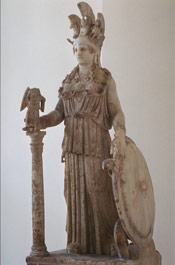Introduction
What is a Greek temple?

Temple of Poseidon (Temple of Hera II) |
Religion was a pervasive presence in the ancient Greek world. From the rites performed by private individuals in the oikos to the grand state ceremonies such as the Panathenaea, performed once every four years, it was an essential feature in the daily lives of citizens, metics, and slaves.
The central focus of state religious practices was the Greek temple. This easily recognizable structure invariably followed a regular pattern of construction: oblong in shape, with pillars running along front and sides (peristyle/peripteral), and a triangulated roof. The temple itself was normally situated within a larger temenos (a sanctuary). The sanctuary could consist simply of a larger walled enclosure to shut off a sacred precinct around the temple and its sacrificial altar or, as at the Sanctuary of Apollo at Delphi, it could include a number of other buildings. These included treasuries to store votive objects given by nations and individuals, workshops for the production of sacred objects, a theater, a stadium, and other buildings relevant to the rites and festivals in honor of the god.
Typically, temples were built on high ground. Obvious examples include the temples on the Acropolis at Athens or the Temple of Aphaia at Aegina.
Why do you think Greek temples were built on high ground? [Answer]
For protection:
- Many sites also contained objects of vast wealth.
- Would be a disaster if temple to gods destroyed by invaders
- Also ideal places for inhabitants of city to defend themselves in case of attack since temples often the most strongly built buildings in the Greek city
For religious purposes:
- To get closer to the gods
What was the function of a Greek temple? [Answer]

Athena Varvakeion |
The answer to this question is not as obvious as you might think. In contrast to modern places of worship (churches, synagogues, mosques), Greek temples were not designed for the populace to enter to pray. The innermost cella [room] was reserved for a colossal statue of the god or goddess represented by the temple. For example, the picture to the right is probably a small scale copy of the 26 foot high statue of Athena that the Greek sculptor Pheidias placed in the Parthenon. In other words, the Greek temple was, literally, the house of the god.
Ordinarily only priests could enter this inner sanctum. At some temples other votive objects would be placed with the god(dess), such as armor, weapons, and other precious artifacts. Many temples also had a special room, the opisthodomos, which were used as state treasuries. The best example is the Parthenon in Athens.
Nonetheless Greek temples were a focus for rites in honor of the appropriate god or goddess. Not infrequently a ‘sacred way’ (a processional route for everyone involved in the rite) would run from the political district of the city to the temple. Once at the temple, sacrifices would take place at an altar situated outside in front of the temple. The whole event had a strong, theatrical aspect designed to appeal to a crowd that could consist of all the members of a polis.
Besides being the god’s dwelling and a focus for rites in his/her honor, temples could also serve as a symbol for a city’s religious, economic, and social prosperity. Not infrequently, as on the Acropolis, tourism was encouraged as visitors from other parts of the Greek world came to view the massive and ornate monuments.
Why study Greek temples?
The study of Greek temples illuminate religious practices within the Greek polis and the interaction of such religious practices with the political, economic, and cultural life of the polis. For the art historian these monuments give insights into the development of Greek architecture and sculpture. Temple decorations also give valuable information about prevailing beliefs, values, and ideologies in individual Greek communities.
Next > Overview: Architectural styles

